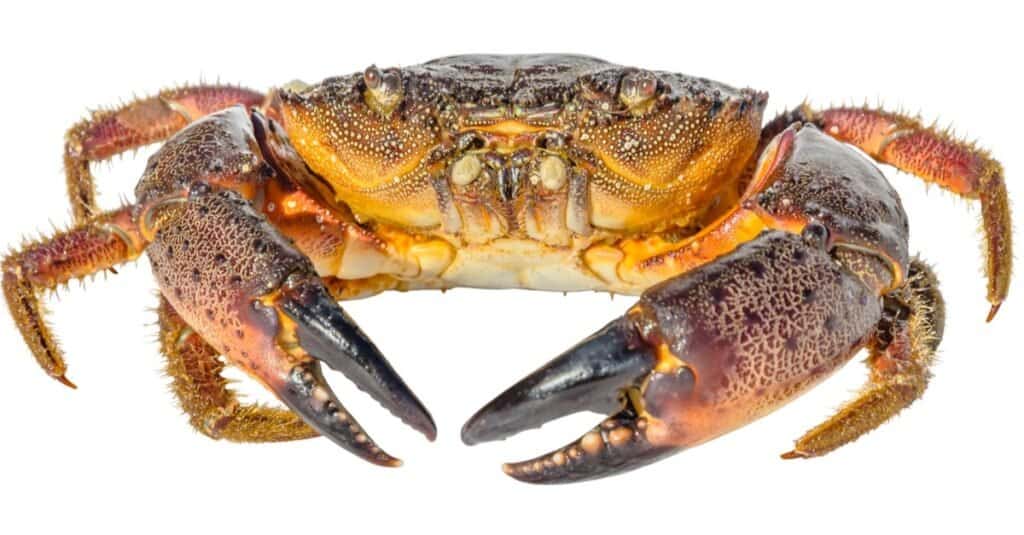The Jonah crab, known scientifically as Cancer borealis, is a fascinating species of crab found along the east coast of North America In this article, we’ll take a deep dive into everything you need to know about this claw-bearing crustacean.
Overview
The Jonah crab is a marine decapod crab that inhabits waters ranging from Newfoundland down to Florida. It has a rough, oval-shaped shell that can grow up to 10 inches wide, with robust, black-tipped claws used for hunting and defense. Jonah crabs are tan to dark reddish-brown in color, helping them blend into rocky and sandy ocean floors where they reside.
While not currently considered threatened, Jonah crab populations are sustainably managed to prevent overfishing. Their sweet, briny flavor and substantial claw meat have made them a popular menu item in recent decades after having long been considered a trash catch.
Physical Characteristics
-
Shell: The Jonah crab’s carapace (top shell) is oval with a rough, bumpy texture. It ranges from light tan to dark reddish-brown.
-
Claws: Thick, black-tipped claws used for hunting, defense, and mating displays. Males’ claws are larger and more robust than females’.
-
Legs Long, slender walking legs Rear swimming legs are flattened into paddles
-
Size Carapace grows up to 10 inches wide. Males typically larger averaging 6-8 inches. Females average 4-5 inches.
-
Weight: 1-3 pounds.
-
Color: Light tan to dark reddish-brown carapace. Legs tan with red banding. White underside.
Habitat and Distribution
Jonah crabs live along the eastern coast of North America, ranging from:
- Newfoundland
- Nova Scotia
- Gulf of Maine
- Mid-Atlantic coast
- Northern Florida
They can be found from the intertidal zone down to depths exceeding 750 meters. Preferred habitats include:
- Rocky substrates with hiding spots
- Seagrass beds
- Mussel and whelk beds
- Sand and mud substrates
Jonah crabs migrate offshore to deeper, warmer waters in autumn and winter. Females move inshore during spring and summer to release larvae.
Diet and Hunting
Jonah crabs are opportunistic bottom-dwelling predators and scavengers. Their diet consists mainly of:
- Mussels
- Clams
- Snails
- Small crabs
- Whelks
- Sea stars
- Fish scraps
They use their strong claws to pry open and crush shells. Their front walking legs dig in sediment and flip over rocks to uncover buried prey. Jonah crabs may also actively hunt fish and other weakened animals.
Life Cycle and Reproduction
-
Maturity: Males mature at 2-3 years old with a carapace around 3 inches wide. Females mature at 3-4 years old over 4 inches wide.
-
Mating: From May to August after the female molts. The male embraces and holds the female for several days.
-
Fertilization: The female stores sperm for up to a year before eggs are fertilized.
-
Brooding: Up to 185,000 eggs are carried under the female’s abdomen for 5-6 months.
-
Larvae: Hatch from February to July depending on location. Go through zoea (planktonic) and megalops (settling) stages.
-
Lifespan: Up to 8 years in ideal conditions.
Fishery and Consumption
-
Long considered a “trash” catch, but demand and value have risen in recent decades.
-
Prized for sweet, briny-flavored claw meat. Often used for crab cakes, seafood platters, soups, bisques.
-
Sustainably fished. Size and catch limits regulated to prevent overfishing.
-
2017 U.S. landings totaled over 17 million lb worth over $12 million.
-
Massachusetts and Rhode Island lead for landings, followed by New Jersey and Maryland.

STORAGE AND SHELF LIFE
When you receive your frozen Jonah crab, store in the freezer. When you are ready to eat it, thaw under refrigeration until fully thawed (approximately 16 to 24 hours) before preparing. For best quality, consume within 6 days, once thawed.
All of our flash-frozen products will arrive frozen, shipped in our 100% recyclable shipping boxes, via UPS. For more information on shipping, visit our FAQ here.

As demand grew for Jonah crab a management plan was developed to promote conservation and allow for sustainable fishing of the species. Those measures include:
- Fishermen must throw back all egg-bearing females, ensuring that fertile crabs are kept in the population.
- Jonah crab may only be caught by fishermen who already hold lobster licenses or were already fishing for Jonah prior to 2015; no new licensees may start fishing.
- No more than 200 crabs per day or 500 crabs per multi-day trip can be caught incidentally through other fishing methods.

Jonah Crab Catch Cleaning & Cook
FAQ
Is Jonah Crab good to eat?
Yes, Jonah crab is considered a delicious and popular seafood choice. It’s known for its sweet, buttery flavor and firm, meaty texture, similar to Dungeness crab.
Why are they called Jonah crabs?
5 Jonah Crab Facts
The Atlantic crab species is related to the Dungness crab of the Pacific. Its geographic range is from Newfoundland, Canada to Florida. The name “Jonah” refers to the character Jonah in the Bible, who was swallowed by a whale, and refers to bad luck.
Is Jonah Crab the same as Dungeness Crab?
No, Jonah crab and Dungeness crab are not the same, though they are related and share some similarities. Jonah crabs are found on the Atlantic coast, while Dungeness crabs are found on the Pacific coast.
Is Jonah Crab the same as stone crab?
No, Jonah crabs and stone crabs are not the same.
